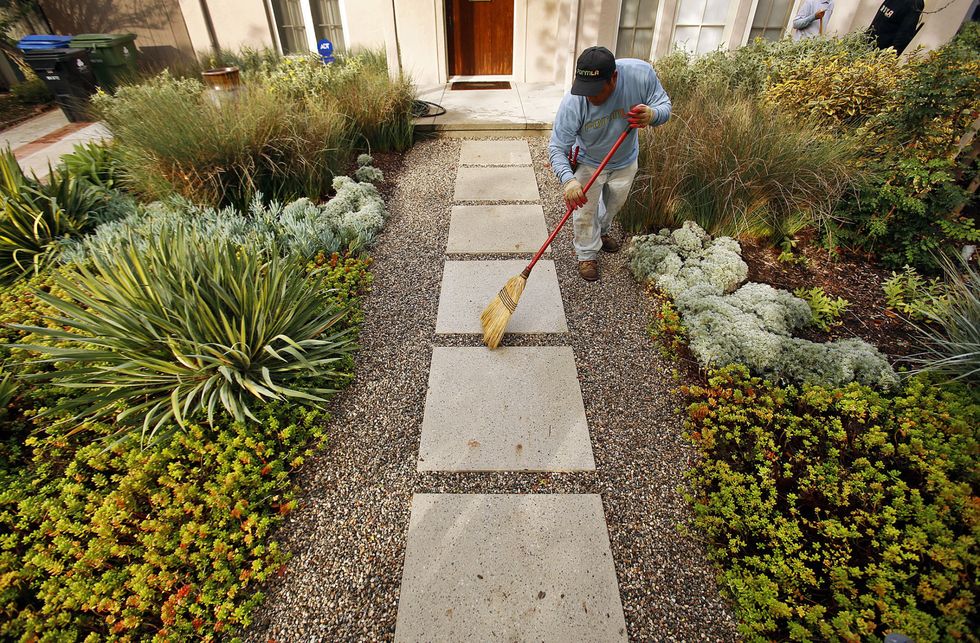A Comprehensive Guide to Creating and Implementing Effective Landscaping Solutions
The art and science of landscaping prolong past mere looks; they include a thoughtful combination of style principles, environmental stewardship, and functional implementation. What techniques can one use to guarantee these landscapes not only grow however also thrive in harmony with their surroundings?

Comprehending Landscape Design Principles
One may wonder what fundamental components add to effective landscape style. At its core, effective landscape design pivots on a number of crucial principles that guide the setup and selection of components within a space. These principles include unity, rhythm, balance, and percentage, each offering to produce a harmonious outside environment.
Unity refers to the natural connection amongst numerous parts, ensuring that they collaborate visually and functionally. Equilibrium can be achieved via unbalanced or symmetrical arrangements, allowing the landscape to feel secure and inviting. Percentage entails recognizing the range of components in connection to each other and the surrounding atmosphere, promoting aesthetic harmony and comfort.

Examining Your Outdoor Space
Prior to executing the concepts of landscape style, a detailed evaluation of your exterior room is vital. This preliminary evaluation helps specify the range of your landscaping job and guarantees that your style aligns with the special features of your property. Begin by analyzing the measurements of your area, taking specific dimensions to comprehend the offered area for numerous aspects such as patio areas, paths, and gardens.
Following, observe the existing features of your landscape, consisting of topography, soil quality, and water drainage patterns. These elements significantly influence plant selection and positioning. Furthermore, evaluate the sunlight exposure across various areas throughout the day, as this will influence the types of plants that grow in your garden.
Take into consideration the microclimates produced by structures, trees, and various other obstacles, as they can affect temperature and moisture levels. Lastly, keep in mind of any kind of existing plants or hardscape aspects that you wish to keep or eliminate. This detailed analysis lays the groundwork for a efficient and well-informed landscape design remedy, ensuring that your design is not just aesthetically pleasing but sustainable and also functional for years to find.
Sustainable Landscaping Strategies
These techniques not just advertise environmental balance yet additionally boost the visual and functional worth of a landscape. Applying efficient irrigation systems, such as drip irrigation, lessens water waste and makes sure that plants obtain appropriate moisture (Palm Desert Landscaping).

Another effective method is the tactical positioning of trees and hedges to supply natural windbreaks and shade, thus decreasing power costs (Palm Desert Landscaping). Rain gardens can be integrated right into the landscape design to take care of stormwater drainage efficiently, filtering system contaminants before they go into rivers
Selecting the Right Plants
Selecting the right plants for your landscape is vital to achieving both aesthetic charm and environmental consistency. The procedure starts with an understanding of your neighborhood environment, dirt conditions, and the specific microenvironments within your landscape. Examining variables such as sunlight exposure, Related Site dampness degrees, and existing plants will certainly aid you select plants that prosper in your special setup.
Think about incorporating native plants, as they are well-adapted to local problems, call for less maintenance, and support neighborhood wildlife. Furthermore, selecting a diverse variety of species can enhance biodiversity while minimizing the threat of condition and bug break outs. It is crucial to review the growth behaviors, flowering durations, and seasonal colors of possible plants to create a vibrant and cohesive landscape.
Additionally, assume about the planned use the space; for example, if the area will experience high foot web traffic, choose resistant ground covers. By thoughtfully picking plants that align with both your visual goals and environmental demands, you can develop a sustainable landscape that not only boosts your building however likewise adds positively to the bordering environment.

Execution and Upkeep Methods
As soon as the appropriate plants have been selected for your landscape, the focus changes to reliable application and ongoing maintenance techniques. Successful installment starts with proper site preparation, which consists of dirt testing to determine nutrient read here levels and pH, adhered to by amending the soil as required. Thoroughly set up plants according to their development habits and light needs, guaranteeing appropriate spacing to advertise healthy growth.
Watering is a crucial aspect of execution. Establish a watering timetable that considers the details needs of each plant species, readjusting for seasonal changes. Utilizing drip watering systems can boost water effectiveness and lower overflow.
Upkeep techniques need to be implemented to make sure the durability and vigor of your landscape. Normal tasks consist of weeding, mulching, and trimming to regulate growth and avoid condition. Fertilization needs to be conducted based on dirt tests, supplying the needed nutrients without over-fertilizing.
Keeping track of for conditions and insects is important; early detection can avoid substantial damages. Lastly, seasonal changes to upkeep routines, such as preparing and winterizing perennials for spring development, will ensure that your landscape continues to be visually attractive and healthy year-round.
Final Thought
Successful application and recurring maintenance further ensure the long life and vigor of landscapes. By integrating these elements, landscapes can be changed right into attractive, practical atmospheres that promote biodiversity and add favorably to neighborhood health.
One might wonder what foundational elements contribute to reliable landscape design. At its core, effective landscape layout hinges on numerous vital principles that direct the setup and selection of components within a room.Choosing the right plants for your landscape is Web Site vital to achieving both aesthetic allure and environmental consistency. It is crucial to review the growth habits, growing durations, and seasonal colors of possible plants to produce a vibrant and natural landscape.
When the right plants have actually been picked for your landscape, the emphasis shifts to effective application and ongoing maintenance techniques.